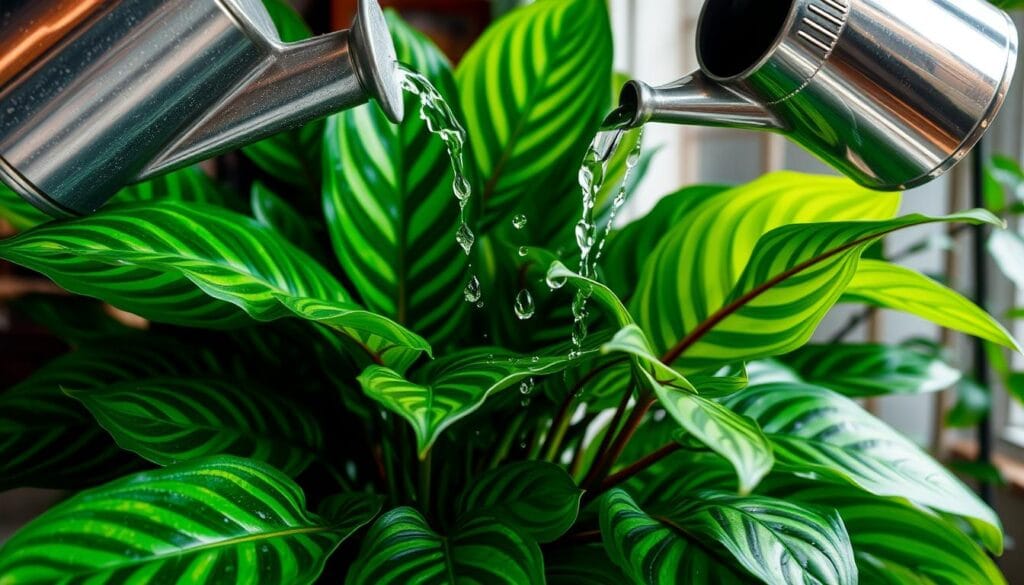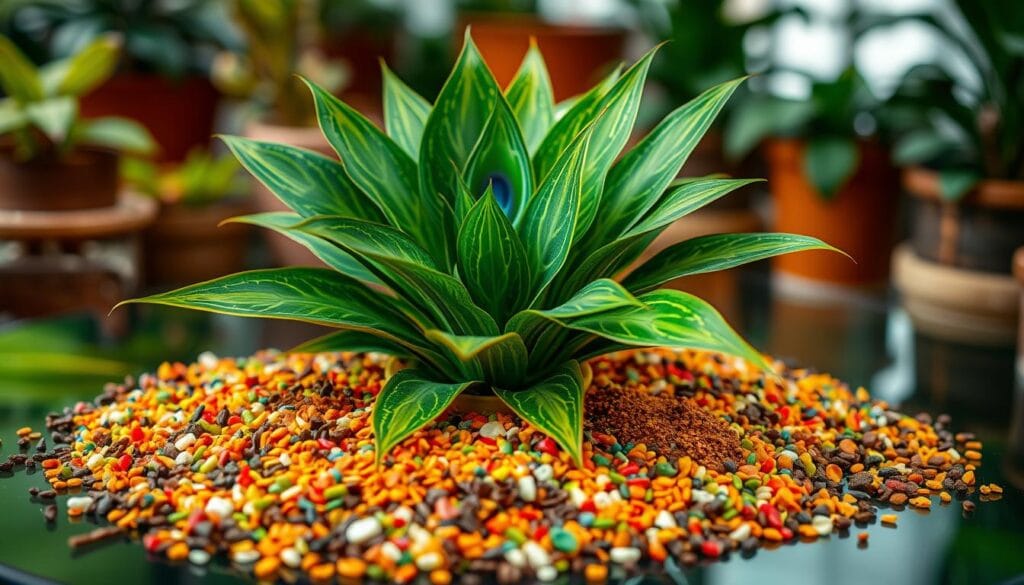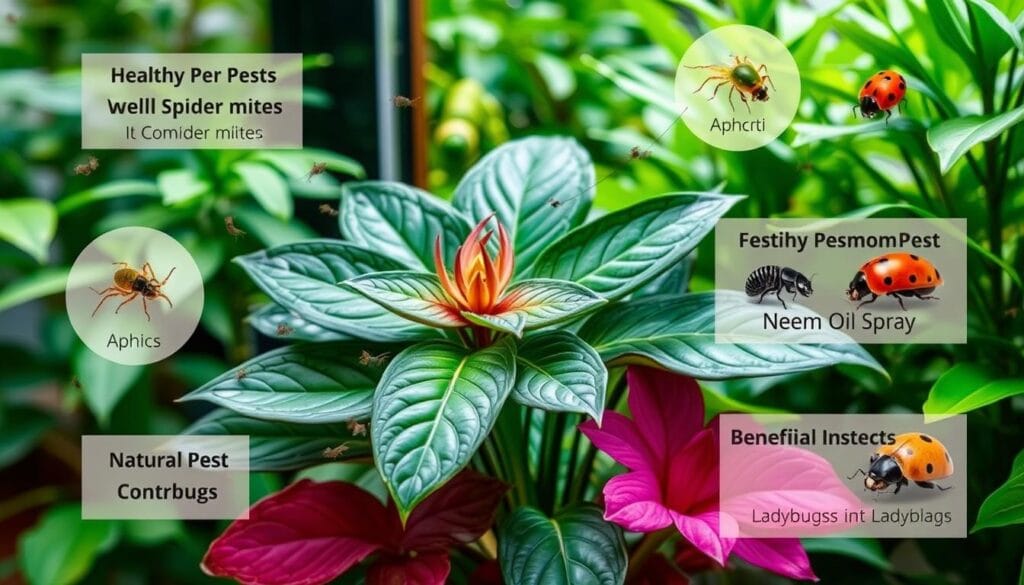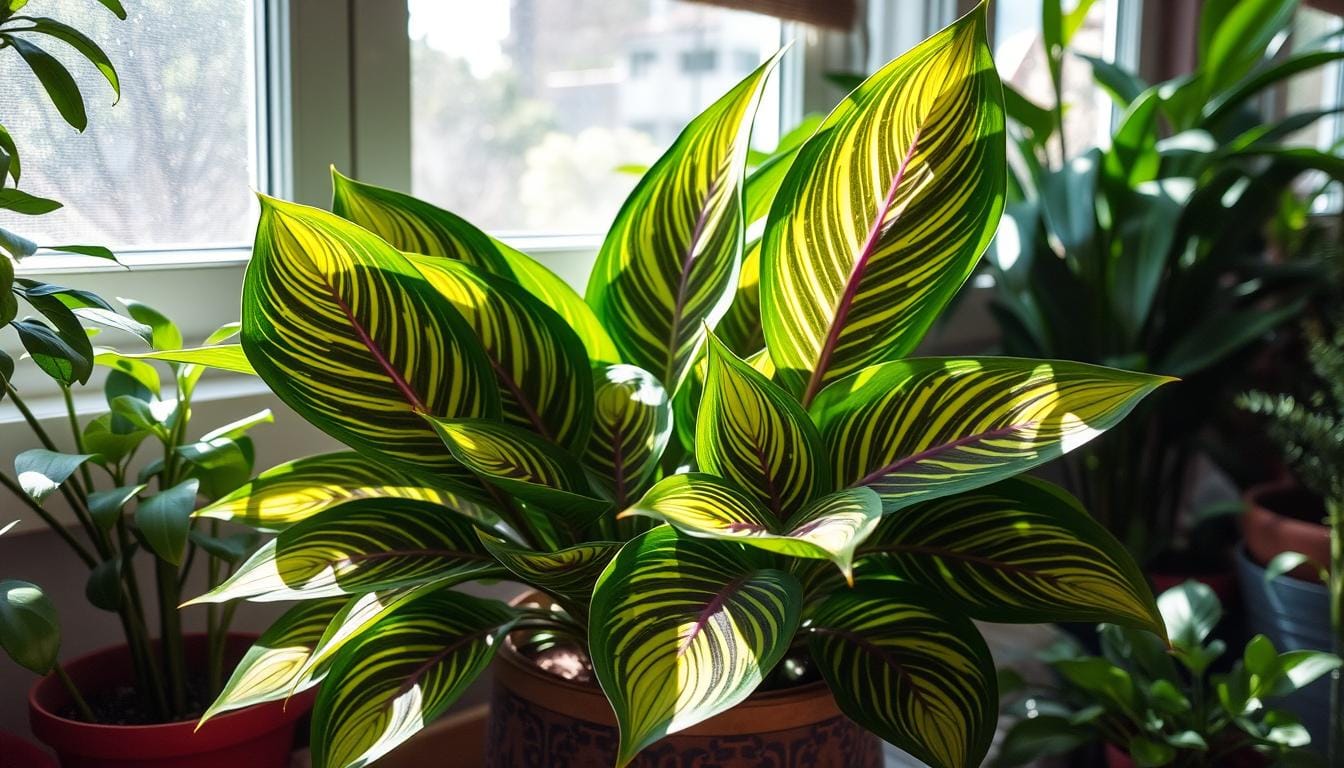Growing Peacock Plant: Care Tips for Indoor Beauty
The Calathea makoyana, also known as the peacock plant, is a stunning tropical houseplant from Brazil. It has eye-catching leaf patterns that look like a peacock’s feathers. The leaves show off shades of green, cream, pink, white, and gray.
It grows to be 1-2 feet tall and 8-12 inches wide. This makes it perfect for indoor spaces. It loves warm, humid places with indirect light.
This plant is known for being non-toxic and can live up to 40 years with the right care. It’s a great choice for anyone looking to add beauty and elegance to their home or office. Its unique look makes it a favorite for those who want to bring a touch of nature indoors.
Key Takeaways
- Calathea makoyana, also known as the peacock plant, is a striking tropical houseplant
- The plant features eye-catching leaf patterns resembling peacock feathers in various shades
- Peacock plants are compact, growing 1-2 feet tall and 8-12 inches wide
- They thrive in warm, humid environments with indirect light and can live up to 40 years
- Peacock plants are non-toxic and make a beautiful addition to indoor spaces
Introduction to the Peacock Plant
The peacock plant, known as Calathea makoyana, is a stunning member of the Calathea genus and the Marantaceae family. It comes from the tropical rainforests of Brazil. This plant is loved for its vibrant, eye-catching foliage that looks like a peacock’s feathers.
Its lush, broad leaves and unique markings make the peacock plant, also called the prayer plant, a favorite for indoor gardens. Its leaves fold up at night and open during the day. This behavior earns it the nickname “prayer plant.”
The peacock plant is part of the Calathea species and is great for indoor spaces. It’s adaptable but needs the right care to thrive. This includes the right light, humidity, and watering.
The peacock plant is a beloved addition to many homes. Its vibrant patterns and captivating leaves add beauty to any indoor space. Whether you’re new to plants or experienced, learning about this species can help you care for it. This will bring joy and natural beauty to your home.
Understanding the Unique Features of Peacock Plants
The calathea makoyana, also known as the peacock plant, is a standout among tropical houseplants. It has ornamental leaves with intricate patterns in shades of green. These leaves also have stunning red-purple undersides and reddish-maroon stems. The peacock plant can grow up to 4 feet tall, adding a bold touch to any room.
Leaf Characteristics
The peacock plant’s broad leaves are its main attraction. They have a pattern that looks like a peacock’s feathers. These leaves are not just beautiful but also clean the air. They remove toxins like formaldehyde, benzene, and trichloroethylene.
Varieties of Peacock Plants
While the calathea makoyana is the most famous peacock plant, there are others like it. These include the Calathea rufibarba (furry feather), Calathea white fusion, Calathea medallion, and Calathea ornata (pinstripe plant). Each has its own unique leaf patterns and colors, offering a wide range of choices for plant lovers.

The peacock plant’s beauty and air-purifying abilities make it a popular choice for homes and offices. With the right care, these tropical plants can flourish indoors. They bring a piece of the rainforest into your space.
Ideal Growing Conditions for Peacock Plants
Peacock plants, also known as Calathea Makoyana, love low light and thrive in warm, tropical places. To make your peacock plant happy indoors, know what light, temperature, and humidity it likes.
Light Requirements
Peacock plants do best in bright, indirect light. They can handle low-light conditions, but they might not look as vibrant. Don’t put them in direct sunlight, as it can burn their leaves. Place your peacock plant near a window that gets at least six hours of filtered sunlight a day.
Temperature and Humidity
Peacock plants love warm, tropical environments with lots of high indoor humidity. They do best in temperatures between 60-75°F (15-24°C). Avoid sudden temperature changes or cold drafts, as they can harm the plant. To keep the air moist, use a pebble tray, group plants, or a humidifier.
| Light Conditions | Temperature Range | Humidity Levels |
|---|---|---|
| Bright, indirect light | 60-75°F (15-24°C) | 60% or more |
By giving your peacock plant the ideal low-light tolerant, tropical environment and keeping the high indoor humidity right, you’ll make it thrive in your home.
Soil and Potting Considerations
Creating the perfect soil and potting environment is key for your peacock plant’s health and growth. These plants love a mix that drains well and is rich in nutrients. It should hold moisture but let excess water go.
Choosing the Right Potting Mix
The best mix for peacock plants combines well-draining soil, organic matter, and peat moss. A good mix is two parts houseplant potting soil, one part sphagnum moss or coco coir, and one part perlite. This mix keeps the soil moist but also lets roots breathe.
Repotting Tips
- Repot your peacock plant every 1-2 years, best in spring or early summer.
- Make sure the pot has holes for drainage to avoid root rot.
- When repotting, gently loosen the roots and fill the new pot with fresh mix.
- Water well after repotting to help the plant settle.
By giving your peacock plant the right soil and potting, it will thrive. It will keep showing off its beautiful, variegated leaves. Check out expert tips on growing and caring for peacock plants to bring out their full beauty indoors.

Watering Your Peacock Plant
Proper watering is key for your peacock plant to stay healthy and vibrant. These plants need consistent moisture but watch out for root rot from too much water.
Frequency and Method
Check the top inch of soil before watering. Water when it’s dry, usually every 1-2 weeks. Use filtered water at room temperature to protect the leaves.
Water the soil until it’s moist but not too wet. This keeps the moisture levels right, preventing the soil from getting too soggy.
Signs of Overwatering
- Yellowing leaves
- Soggy, wet soil
- Presence of root rot
If you see these signs, it’s time to change how you water. Let the soil dry a bit before watering again. If the roots are badly damaged, consider repotting the plant.
| Watering Frequency | Soil Moisture | Temperature | Humidity |
|---|---|---|---|
| Every 1-2 weeks | Top inch feels dry | Room temperature | High humidity preferred |

“Consistent moisture is key for healthy peacock plants, but be sure to avoid waterlogging the soil, which can lead to root issues.”
Fertilization for Vibrant Growth
To keep your peacock plant healthy and vibrant, you need the right fertilizer. These plants do well with a balanced, water-soluble fertilizer. Dilute it to half strength and apply every 4-6 weeks in spring and summer.
Types of Fertilizers to Use
For optimal growth, a balanced fertilizer is key. But organic fertilizers can also help your peacock plant. Options like compost or well-rotted manure improve soil quality and release nutrients slowly. This is great for fixing nutrient deficiencies that might cause yellow leaves or slow growth.
Feeding Schedule
- Feed your peacock plant with a balanced, water-soluble fertilizer diluted to half strength every 4-6 weeks during the growing season (spring and summer).
- Reduce or stop fertilizing in the fall and winter when growth slows down.
- Consider adding organic balanced fertilizers to improve soil quality and provide a steady supply of nutrients.
By sticking to this fertilization routine, your peacock plant will get the nutrients it needs. This will help it thrive and keep its foliage vibrant and eye-catching.

Common Pests and How to Manage Them
Peacock plants are mostly pest-resistant. But, they can still get pests. It’s important to check them often and take action early to keep them healthy.
Identifying Common Pests
Peacock plants face pests like spider mites, scale insects, fungus gnats, mealybugs, aphids, whiteflies, and weevils. These pests can make leaves turn yellow, plants grow slowly, and even drop leaves if not treated.
Spider mites are tiny, spider-like creatures that feed on plant sap. This affects photosynthesis and plant health. Scale insects suck sap, causing weak growth and yellow leaves. Fungus gnats damage roots, leading to wilting and poor nutrient uptake.
Mealybugs weaken plants, causing distorted growth and yellow leaves. Aphids feed on sap, causing curled leaves and stunted growth. They also attract ants. Whiteflies sap plant energy, leading to honeydew and sooty mold. Weevils target leaves and roots, causing stress and leaf drop.
Natural Pest Control Solutions
There are natural ways to manage pests on your peacock plant. The key is to watch closely and act fast when you see pests.
- Use neem oil as a natural pesticide for minor infestations.
- Keep the plant area humid to make it less welcoming for pests.
- Bring in beneficial insects, like ladybugs, to eat pests.
- Make sure the plant gets enough light, water, and nutrients to stay healthy and pest-resistant.
- Quarantine new plants before adding them to your collection to stop pests from spreading.
By being alert and using natural pest control, you can keep your peacock plant healthy and pest-free.

Pruning and Maintenance Techniques
Keeping your peacock plant healthy and beautiful takes some effort. With the right pruning and regular care, your plant will flourish. It will show off its stunning leaves and promote leaf health and growth promotion.
When and How to Prune
Prune your peacock plant in the fall and winter. Use sharp scissors or pruning shears to cut off dead or damaged parts. This keeps the plant looking good and encourages more growth.
Benefits of Regular Maintenance
- Promotes overall plant health by removing dead or damaged foliage
- Enhances the plant’s visual appeal by trimming unruly leaves and maintaining a tidy appearance
- Encourages the production of new, healthy leaves and stems, contributing to leaf health
- Allows for better air circulation around the plant, reducing the risk of pests and diseases
- Supports the plant’s natural growth cycle by stimulating the production of new growth
Regular plant grooming is also important. Gently wiping the leaves with a damp cloth keeps them clean and healthy. This simple step removes dust and keeps the leaves vibrant.
By adding these pruning and maintenance steps to your routine, your peacock plant will thrive. It will bring a touch of tropical beauty to your home.
Propagation Methods for Peacock Plants
It’s easy to grow more peacock plants using division and stem cuttings. These methods help you multiply your plants. You can share their beautiful leaves with others.
Division Method
Division is the top choice for growing peacock plants, especially in spring or summer. Split the root ball into smaller parts, making sure each has enough roots and leaves. Water the plant a day before to help it adjust. Division is a simple and efficient way to propagate peacock plants and encourage new growth.
Stem Cuttings
Stem cuttings are another way to grow peacock plants. Cut 4-6 inch pieces from the stem, just below a leaf node. Place the cuttings in water or moist soil. Keep them warm and humid until they grow roots. Allow the newly propagated plants to establish themselves before introducing fertilizer to support their growth.
Success in growing peacock plants depends on careful handling and the right conditions. Be patient as the new plants grow. With a bit of effort, you can grow more peacock plants and enjoy their leaves for years.
Troubleshooting Common Issues
Peacock plants are known for their bright leaves and lush growth. But, they can face some common problems. Knowing the causes and how to fix them helps keep your plant healthy and happy indoors.
Yellowing Leaves
Yellow leaves on a peacock plant can happen for a few reasons. Too much water often causes root rot and imbalances. Try watering less and making sure the soil drains well.
Not enough light can also make leaves turn yellow. Make sure your plant gets enough bright, indirect light.
Leaf Drop Problems
Peacock plants naturally shed leaves as they settle in. But, too much leaf drop might mean a bigger problem. Temperature changes or too much water can make leaves fall off early.
Keep the temperature and humidity steady. Also, watch how much you water to stop too many leaves from falling.
| Common Issue | Probable Cause | Corrective Measures |
|---|---|---|
| Yellowing Leaves | Overwatering, low light | Adjust watering schedule, provide bright, indirect light |
| Leaf Drop | Temperature stress, overwatering | Maintain stable temperature and humidity, monitor watering |
| Brown Leaf Edges | Low humidity, mineral buildup | Increase humidity, flush soil with distilled water |
| Curling Leaves | Underwatering, low humidity | Water regularly, increase humidity levels |
| Loss of Leaf Patterns | Improper lighting, under-fertilization | Adjust lighting, apply a general all-purpose liquid fertilizer |
By watching your plant closely and fixing problems fast, you can keep it healthy and beautiful. It will add a natural beauty to your home.
“The key to keeping your peacock plant thriving is to pay close attention to its needs and make adjustments as necessary.”
Enjoying Your Peacock Plant at Home
Make your living spaces more vibrant with a Peacock Plant. These plants are perfect for decorative pots, adding beauty to your home. Group them with other plants for a lush, tropical-inspired look that brings peace.
Decorating Tips
Place your Peacock Plant in spots like living rooms or offices. It adds elegance and beauty to any room. Try different pots to match your style and space.
Feng Shui Benefits
The Peacock Plant is thought to bring good energy and balance in Feng Shui. It purifies the air, making it great for bedrooms and offices. Its tropical look also brings calm and balance, creating a peaceful space.


